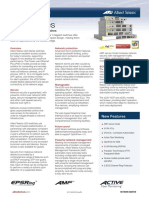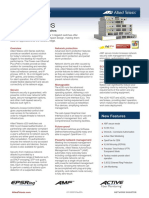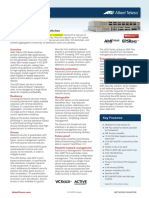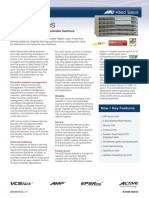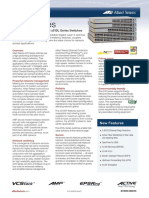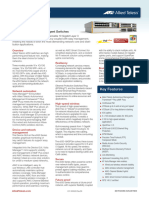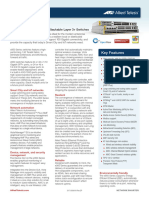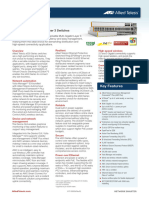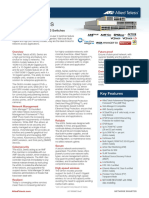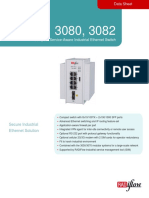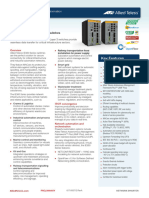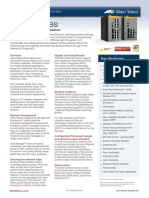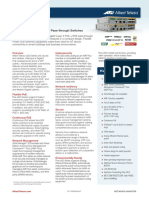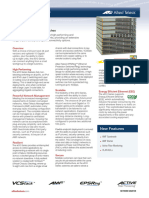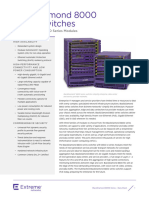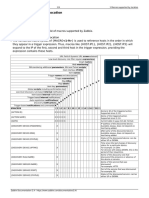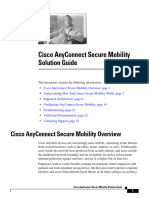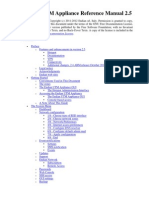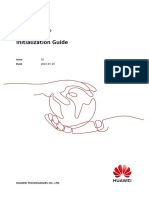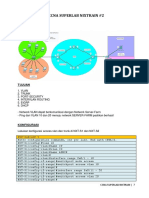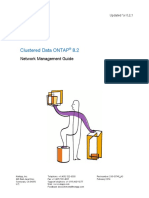Data Sheets (EN)
Data Sheets (EN)
Uploaded by
danut.helinickCopyright:
Available Formats
Data Sheets (EN)
Data Sheets (EN)
Uploaded by
danut.helinickOriginal Title
Copyright
Available Formats
Share this document
Did you find this document useful?
Is this content inappropriate?
Copyright:
Available Formats
Data Sheets (EN)
Data Sheets (EN)
Uploaded by
danut.helinickCopyright:
Available Formats
Switches | Product Information
x230 Series
Enterprise Gigabit Edge Switches
The Allied Telesis x230 Series of Layer 3 Gigabit switches offer
an impressive set of features in a compact design, making them
ideal for applications at the network edge.
Overview Network protection
Allied Telesis x230 Series switches Advanced storm protection features
provide an excellent access solution include bandwidth limiting, policy- AMF secure mode increases network
for today’s networks, supporting based storm protection and packet security with management traffic
Gigabit to the desktop for maximum storm protection. encryption, authorization, and
performance. The Power over Ethernet monitoring.
Plus (PoE+) models provide an ideal Network storms are often caused by
solution for connecting and remotely cabling errors that result in a network ECO friendly
powering wireless access points, IP loop. Allied Telesis x230 Series switches The x230 Series supports Energy
video surveillance cameras, and IP provide features to detect loops as soon Efficient Ethernet, which automatically
phones. With 8, 16 or 24 Gigabit ports, as they are created. Loop detection and reduces the power consumed by
SFP uplinks, and fanless models thrash limiting take immediate action to the switch whenever
for silent operation, the x230 Series prevent network storms. there is no traffic on a
enable flexible deployment and secure port. This sophisticated
connectivity at the network edge. Manageable feature can significantly reduce your
The x230 runs the advanced operating costs by reducing the power
Secure AlliedWare Plus™ fully featured requirements of the switch and any
Network security is guaranteed, with operating system, delivering a rich associated cooling equipment.
powerful control over network traffic feature set and an industry-standard
types, secure management options, Command Line Interface (CLI). This The x230-10GT and x230L* models
and other multi-layered security reduces training requirements and are fanless, providing silent operation,
features built right in. is consistent across all AlliedWare which makes them ideal for desktop or
Plus devices, simplifying network work area deployment.
Network Access Control (NAC) management.
gives unprecedented control over
user access to the network, in The web-based Graphical User
order to mitigate threats to network Interface (GUI) is an easy-to-use and
infrastructure. powerful management tool, with
comprehensive monitoring facilities.
Allied Telesis x230 switches use ۼۼAMF secure mode
802.1x port-based authentication, in Future-proof ۼۼVLAN ACLs
partnership with standards-compliant x230 Series switches are Software
dynamic VLAN assignment, to assess Defined Networking (SDN) ready and ۼۼTACACS+ Command Authorization
a user’s adherence to network security able to support OpenFlow v1.3.
policies and either grant access or ۼۼActive Fiber Monitoring
offer remediation. Tri-authentication Powerful network management
ensures the network is only accessed ۼۼOpenFlow for SDN
Meeting the increased management
by known users and devices. Secure requirements of modern converged ۼۼVLAN Mirroring (RSPAN)
access is also available for guests. networks, Allied Telesis Autonomous
Management Framework (AMF) ۼۼPrecision Time Protocol (PTP)
Security from malicious network automates many everyday tasks Transparent Mode
attacks is provided by a including configuration management.
comprehensive range of features such The complete network can be ۼۼFanless models provide silent
as DHCP snooping, STP root guard, managed as a single virtual device operation
BPDU protection and access control with powerful centralized management
lists. Each of these can be configured features. Growing the network can
to perform a variety of actions upon be accomplished with plug-and-play
detection of a suspected attack. simplicity, and network node recovery *x230L-26GT available Q4 2018
is fully zero-touch.
alliedtelesis.com 617-000519 RevZH NETWORK SMARTER
x230 Series | Enterprise Gigabit Edge Switches
ۼۼ
Key Features
Allied Telesis Autonomous ۼۼBandwidth limiting minimizes the effects of the UniDirectional Link Detection
Management Framework (AMF) storm by reducing the amount of flooding traffic. ۼۼUniDirectional Link Detection (UDLD) is useful
ۼۼAllied Telesis Autonomous Management ۼۼPolicy-based storm protection is more powerful for monitoring fiber-optic links between two
Framework (AMF) is a sophisticated suite of than bandwidth limiting. It restricts storm damage switches that use two single-direction fibers to
management tools that provide a simplified to within the storming VLAN, and it provides the transmit and receive packets. UDLD prevents
approach to network management. Common flexibility to define the traffic rate that creates a traffic from being sent across a bad link by
tasks are automated or made so simple that broadcast storm. The action the device should blocking the ports at both ends of the link in the
the every-day running of a network can be take when it detects a storm can be configured, event that either the individual transmitter or
achieved without the need for highly-trained, and such as disabling the port from the VLAN or receiver for that connection fails.
expensive, network engineers. Powerful features shutting the port down.
like centralized management, auto-backup, auto-
ۼۼPacket storm protection allows limits to be set on Optical DDM
upgrade, auto-provisioning and auto-recovery ۼۼMost modern optical SFP/SFP+/XFP
the broadcast reception rate, multicast frames and
enable plug-and-play networking and transceivers support Digital Diagnostics
destination lookup failures. In addition, separate
zero-touch management. Monitoring (DDM) functions according to the
limits can be set to specify when the device will
ۼۼAMF secure mode encrypts all AMF traffic, discard each of the different packet types. specification SFF-8472. This enables real
provides unit and user authorization, and time monitoring of the various parameters of
monitors network access to greatly enhance Loop protection the transceiver, such as optical output power,
network security. temperature, laser bias current and transceiver
ۼۼThrash limiting, also known as Rapid MAC
supply voltage. Easy access to this information
movement, detects and resolves network loops.
Power over Ethernet Plus (PoE+) simplifies diagnosing problems with optical
It is highly user-configurable — from the rate
ۼۼWith PoE, a separate power connection to media modules and fiber connections.
of looping traffic to the type of action the switch
endpoints such as IP phones and wireless access should take when it detects a loop.
points is not necessary. PoE+ reduces costs Active Fiber Monitoring
ۼۼWith thrash limiting, the switch only detects a
and provides even greater flexibility, providing
loop when a storm has occurred, which can ۼۼActive Fiber Monitoring prevents eavesdropping
the capability to connect devices requiring more on fiber communications by monitoring received
potentially cause disruption to the network. To
power (up to 30 Watts) such as tilt and zoom optical power. If an intrusion is detected, the
avoid this, loop detection works in conjunction
security cameras. link can be automatically shut down, or an
with thrash limiting to send special packets, called
Loop Detection Frames (LDF), that the switch operator alert can be sent.
Ethernet Protection Switched Ring listens for. If a port receives an LDF packet, one
(EPSRingTM) can choose to disable the port, disable the link, or VLAN Mirroring (RSPAN)
ۼۼEPSRing allows several x230 switches to join send an SNMP trap. ۼۼVLAN mirroring allows traffic from a port on
a protected ring capable of recovery within as a remote switch to be analysed locally. Traffic
little as 50ms. This feature is perfect for high Spanning Tree Protocol (STP) Root being transmitted or received on the port is
availability in enterprise networks. Guard duplicated and sent across the network on a
ۼۼSTP root guard designates which devices can special VLAN.
Access Control Lists (ACLs) assume the root bridge role in an STP network.
ۼۼThe x230 Series features industry-standard This stops an undesirable device from taking Find Me
access control functionality through ACLs. ACLs over this role, where it could either compromise ۼۼIn busy server rooms comprised of a large
filter network traffic to control whether packets network performance or cause a security number of equipment racks, it can be quite a
are forwarded or blocked at the port interface. weakness. job finding the correct switch quickly among
This provides a powerful network security many similar units. The “Find Me” feature
mechanism to select the types of traffic to be Bridge Protocol Data Unit (BPDU) is a simple visual way to quickly identify the
analyzed, forwarded, or influenced in some way. protection desired physical switch for maintenance or
An example of this would be to provide traffic other purposes, by causing its LEDs to flash in
flow control.
ۼۼBPDU protection adds extra security to STP. It
a specified pattern.
protects the spanning tree configuration by
preventing malicious DoS attacks caused by
VLAN ACLs spoofed BPDUs. If a BPDU packet is received on IPv6 Support
ۼۼSimplify access and traffic control across entire a protected port, the BPDU protection feature ۼۼWith the depletion of IPv4 address space, IPv6
segments of the network. Access Control Lists disables the port and alerts the network manager. is rapidly becoming a mandatory requirement for
(ACLs) can be applied to a Virtual LAN (VLAN) as many government and enterprise customers. To
well as a specific port. Tri-authentication meet this need, now and into the future, the x230
Series supports IPv6 forwarding in hardware
ۼۼAuthentication options on the x230 Series
Easy To Manage and features MLD snooping for efficient use of
include alternatives to 802.1x port-based
ۼۼThe AlliedWare Plus operating system network bandwidth.
authentication, such as web authentication, to
incorporates an industry standard CLI, facilitating enable guest access and MAC authentication for
intuitive manageability. end points that do not have an 802.1x supplicant. Precision Time Protocol (PTP)
ۼۼWith three distinct modes, the CLI is very secure, All three authentication methods—802.1x, ۼۼPTP (IEEE 1588v2) sychronizes clocks
and the use of SSHv2 encrypted and strongly MAC-based and Web-based—can be enabled throughout the network with micro-second
authenticated remote login sessions ensures CLI simultaneously on the same port, resulting in accuracy, supporting industrial automation and
access is not compromised. tri-authentication. control systems.
ۼۼAs a Layer 2+ switch, a static route can be added
to allow a user in a different subnet to manage TACACS+ Command Authorization Flexible deployment
the switch. ۼۼCentralize control of which commands may ۼۼThe x230-10GT and x230L* models are
be issued by a specific user of an AlliedWare fanless for silent operation. This enables switch
Plus device. TACACS+ command authorization placement in work spaces and on desktops with
Storm protection
complements authentication and accounting no interruption to network users.
Advanced packet storm control features protect the services for a complete AAA solution.
network from broadcast storms: *x230L-26GT available Q4 2018
2 | x230 Series 617-000519 RevZH
x230 Series | Enterprise Gigabit Edge Switches
Key Solutions
Network convergence
The convergence of network services in the
Enterprise has led to increasing demand for
highly available networks with minimal downtime.
Diagram 1 shows x230 switches with high
x2
30
performance EPSR connectivity to the x930
VCStack core. This topology provides recovery in
as little as 50ms, if required.
x2
x2
30
30
Network flexibility
Flexible network deployment is facilitated by the
compact 10 and 18 port x230 PoE+ models,
x2
30
as shown in the Campus network in diagram
2. With the growth of wireless networking and
x9 x60
30 0-2
digital security, the x230 PoE+ models are ideal Servers
4
supplying connectivity and power at the network
edge, supporting the full 30 watts of PoE+. The
fanless x230L models provide silent operation to
enable deployment in work areas.
Diagram 1
AMF provides an easy yet powerful solution
for managing multiple devices with
plug-and-play simplicity.
x2
30
x5 x60
10 0-2
4
x2
30
x2
30
0L
xx22330L
x5 x60
10 0-2
4
x2
30
Network Attached
00LL
xx2233 Storage
Campus
Data Center
0
SB
x5110
x8
11
x5
2
Server
Rack
Ro
Master
ut
er
10 Gigabit link
Internet
1 Gigabit link
Link aggregation
Diagram 2
NETWORK SMARTER 617-000519 RevZH x230 Series | 3
x230 Series | Enterprise Gigabit Edge Switches
Product Specifications
10/100/1000T (RJ-45) POE+ ENABLE
PRODUCT 100/1000X SFP PORTS TOTAL PORTS SWITCHING FABRIC FORWARDING RATE
COPPER PORTS PORTS
x230-10GP 8 2 10 8 20Gbps 14.9Mpps
x230-10GT 8 2 10 - 20Gbps 14.9Mpps
x230-18GP 16 2 18 16 36Gbps 26.8Mpps
x230-18GT 16 2 18 - 36Gbps 26.8Mpps
x230-28GP 24 4 28 24 56Gbps 41.7Mpps
x230-28GT 24 4 28 - 56Gbps 41.7Mpps
x230L-17GT 16 1 17 - 34Gbps 25.3Mpps
x230L-26GT* 24 2 26 - 52Gbps 38.7Mpps
Physical specifications Latency (microseconds)
PRODUCT WIDTH X DEPTH X HEIGHT WEIGHT PACKAGED DIMENSIONS WEIGHT PORT SPEED
PRODUCT
210 x 275 x 42.5 mm 2.1 kg (4.6 lb) 43 x 36 x 15 cm 3.45 kg (7.6 lb) 10MBPS 100MBPS 1GBPS
x230-10GP
(8.27 x 10.83 x 1.67 in) (16.93 x 14.17 x 5.90 in)
x230-10GP/GT 55µs 7.8µs 3.4µs
x230-10GT 265 x 180 x 42.5 mm 1.5 kg (3.3 lb) 43 x 36 x 15 cm 2.85 kg (6.3 lb)
(10.43 x 7.08 x 1.67 in) (16.93 x 14.17 x 5.90 in) x230-18GP/GT 56µs 7.9µs 3.4µs
341 x 231 x 44 mm 3.0 kg (6.6 lb) 43 x 36 x 15 cm 4.35 kg (9.6 lb) x230-28GP/GT 59µs 8.6µs 4.3µs
x230-18GP
(13.42 x 9.09 x 1.73 in) (16.93 x 14.17 x 5.90 in)
x230L-17GT 56µs 7.9µs 3.4µs
x230-18GT 341 x 231 x 44 mm 2.4 kg (5.3 lb) 43 x 36 x 15 cm 4.0 kg (8.8 lb)
(13.42 x 9.09 x 1.73 in) (16.93 x 14.17 x 5.90 in) x230L-26GT* 59µs 8.6µs 4.3µs
x230-28GP 440 x 290 x 44 mm 4.7 kg (10.4 lb) 53 x 43 x 15 cm 6.35 kg (14.0 lb)
(17.32 x 11.42 x 1.73 in) (20.86 x 16.93 x 5.90 in)
x230-28GT and 341 x 231 x 44 mm 2.4 kg (5.3 lb) 43 x 36 x 15 cm 4.0 kg (8.8 lb)
x230L-26GT* (13.42 x 9.09 x 1.73 in) (16.93 x 14.17 x 5.90 in)
x230L-17GT 341 x 210 x 44 mm 43.5 x 40 x 14.5 cm 3.4 kg (7.5 lb)
2.2 kg (4.85 lb)
(13.42 x 8.27 x 1.73 in) (17.13 x 15.71 x 5.71 in)
*x230L-26GT available Q4 2018
Performance IP features ۼۼWirespeed traffic classification with low latency
ۼۼUp to 16K MAC addresses ۼۼIPv4 static routing and RIP essential for VoIP and real-time streaming media
ۼۼUp to 512 multicast entries applications
ۼۼDHCPv6 client
ۼۼ256MB DDR SDRAM (GP models) ۼۼPolicy-based QoS based on VLAN, port, MAC and
ۼۼDevice management over IPv6 networks with general packet classifiers
ۼۼ512MB DDR SDRAM (GT models) SNMPv6, Telnetv6, SSHv6 and Syslogv6
ۼۼPolicy-based storm protection
ۼۼ2048 configurable VLANs (GP models) ۼۼNTPv6 client and server
ۼۼExtensive remarking capabilities
ۼۼ4094 configurable VLANs (GT models)
Management ۼۼTaildrop for queue congestion control
ۼۼ64MB flash memory ۼۼAllied Telesis Management Framework (AMF) ۼۼStrict priority, weighted round robin or mixed
ۼۼPacket Buffer memory: 1.5MB enables powerful centralized management and scheduling
ۼۼSupports 10KB jumbo frames zero-touch device installation and recovery
ۼۼIP precedence and DiffServ marking based on layer
ۼۼWirespeed forwarding ۼۼConsole management port on the front panel for 2, 3 and 4 headers
ease of access
Reliability ۼۼEco-friendly mode allows ports and LEDs to be Resiliency
ۼۼModular AlliedWare Plus operating system disabled to save power ۼۼControl Plane Prioritization (CPP) ensures the
ۼۼFull environmental monitoring of PSU internal ۼۼWeb-based Graphical User Interface (GUI) CPU always has sufficient bandwidth to process
network control traffic
temperature and internal voltages. SNMP traps ۼۼIndustry-standard CLI with context-sensitive help
alert network managers in case of any failure ۼۼDynamic link failover (host attach)
ۼۼPowerful CLI scripting engine with built-in text editor
ۼۼEPSRing (Ethernet Protection Switched Rings) with
Flexibility and compatibility ۼۼSD/SDHC memory card socket allows software enhanced recovery for extra resiliency
release files, configurations and other files to be
ۼۼSFP ports will support any combination of ۼۼLoop protection: loop detection and thrash limiting
stored for backup and distribution to other devices
10/100/1000T, 100X, 100FX, 100BX, 1000X,
1000SX, 1000LX, 1000ZX or 1000ZX CWDM ۼۼConfigurable logs and triggers provide an audit trail ۼۼPVST+ compatibility mode
SFPs of SD card insertion and removal ۼۼRRP snooping
ۼۼComprehensive SNMP MIB support for standards- ۼۼSTP root guard
Diagnostic tools based device management
ۼۼActive Fiber Monitoring detects tampering on ۼۼManagement stacking allows up to 24 devices to Security
optical links be managed from a single console ۼۼAccess Control Lists (ACLs) based on layer 3 and 4
ۼۼBuilt-In Self Test (BIST) ۼۼEvent-based triggers allow user-defined scripts to headers, per VLAN or port
ۼۼFind-me device locator be executed upon selected system events ۼۼConfigurable ACLs for management traffic
ۼۼCable fault locator (TDR) ۼۼAuth-fail and guest VLANs
ۼۼOptical Digital Diagnostics Monitoring (DDM)
Quality of Service (QoS) ۼۼAuthentication, Authorization and Accounting
ۼۼ8 priority queues with a hierarchy of high priority (AAA)
ۼۼAutomatic link flap detection and port shutdown queues for real time traffic, and mixed scheduling, ۼۼBootloader can be password protected for device
ۼۼPing polling for IPv4 and IPv6 for each switch port security
ۼۼPort and VLAN mirroring (RSPAN) ۼۼLimit bandwidth per port or per traffic class down ۼۼBPDU protection
to 64kbps
ۼۼTraceRoute for IPv4 and IPv6
4 | x230 Series 617-000519 RevZH
x230 Series | Enterprise Gigabit Edge Switches
ۼۼDHCP snooping, IP source guard and Dynamic ARP Environmental specifications Electrical approvals and compliances
Inspection (DAI) ۼۼOperating temperature range: ۼۼEMC: EN55022 class A, FCC class A, VCCI class A
ۼۼDynamic VLAN assignment 0°C to 50°C (32°F to 122°F) ۼۼImmunity: EN55024, EN61000-3-levels 2
ۼۼMAC address filtering and MAC address lock-down 0°C to 40°C (32°F to 104°F) (x230L models) (Harmonics), and 3 (Flicker) – AC models only
ۼۼNetwork Access and Control (NAC) features Derated by 1°C per 305 meters (1,000 ft)
manage endpoint security Safety
ۼۼStorage temperature range:
ۼۼPort-based learn limits (intrusion detection) ۼۼStandards: UL60950-1, CAN/CSA-C22.2 No.
-20°C to 60°C (-4°F to 140°F) 60950-1-03, EN60950-1, EN60825-1, AS/NZS
ۼۼPrivate VLANs provide security and port isolation Operating relative humidity range: 60950.1
for multiple customers using the same VLAN
0% to 80% non-condensing ۼۼCertifications: UL, cUL, UL-EU
ۼۼSecure Copy (SCP)
ۼۼStorage relative humidity range:
ۼۼStrong password security and encryption Restrictions on Hazardous Substances
0% to 95% non-condensing
ۼۼTri-authentication: MAC-based, web-based and (RoHS) Compliance
IEEE 802.1x ۼۼOperating altitude: ۼۼEU RoHS compliant
ۼۼRADIUS group selection per VLAN or port 2,000 meters maximum (6,562 ft) ۼۼChina RoHS compliant
Country of origin
ۼۼChina
Power characteristics: 100-240 VAC, 50-60Hz, 2.4A maximum
NO POE LOAD FULL POE+ LOAD MAX POE MAX POE+
MAX POE
PRODUCT PORTS AT 15W PORTS AT 30W
MAX POWER MAX HEAT MAX POWER MAX HEAT POWER
NOISE NOISE PER PORT PER PORT
CONSUMPTION DISSIPATION CONSUMPTION DISSIPATION
x230-10GP 16W 55 BTU/hr 33 dBA 180W 126 BTU/hr 41 dBA 124W 8 4
x230-10GT 16W 55 BTU/hr Fanless - - - - - -
x230-18GP 21W 72 BTU/hr 34 dBA 330W 169 BTU/hr 42 dBA 247W 16 8
x230-18GT 18W 61 BTU/hr 29 dBA - - - - - -
x230-28GP 37W 127 BTU/hr 34 dBA 520W 303 BTU/hr 42 dBA 370W 24 12
x230-28GT 26W 89 BTU/hr 34 dBA - - - - - -
x230L-17GT 15W 51 BTU/hr Fanless - - - - - -
x230L-26GT* 20.5W 70 BTU/h Fanless - - - - - -
*x230L-26GT available Q4 2018
Standards and Protocols Ethernet IPv6 Features
IEEE 802.2 Logical Link Control (LLC) RFC 1981 Path MTU discovery for IPv6
AlliedWare Plus Operating System IEEE 802.3 Ethernet RFC 2460 IPv6 specification
Version 5.4.8-1 IEEE 802.3ab1000BASE-T RFC 2464 Transmission of IPv6 packets over Ethernet
IEEE 802.3af Power over Ethernet (PoE) networks
Cryptographic Algorithms IEEE 802.3at Power over Ethernet plus (PoE+) RFC 3484 Default address selection for IPv6
FIPS Approved Algorithms IEEE 802.3az Energy Efficient Ethernet (EEE) RFC 3587 IPv6 global unicast address format
Encryption (Block Ciphers): IEEE 802.3u 100BASE-X RFC 3596 DNS extensions to support IPv6
ۼۼAES (ECB, CBC, CFB and OFB Modes) IEEE 802.3x Flow control - full-duplex operation RFC 4007 IPv6 scoped address architecture
IEEE 802.3z 1000BASE-X RFC 4193 Unique local IPv6 unicast addresses
ۼۼ3DES (ECB, CBC, CFB and OFB Modes) IEEE 1588v2 Precision clock synchronization protocol v2 RFC 4213 Transition mechanisms for IPv6 hosts and
Block Cipher Modes: routers
ۼۼCCM IPv4 Features RFC 4291 IPv6 addressing architecture
ۼۼCMAC RFC 768 User Datagram Protocol (UDP) RFC 4443 Internet Control Message Protocol (ICMPv6)
RFC 791 Internet Protocol (IP) RFC 4861 Neighbor discovery for IPv6
ۼۼGCM RFC 792 Internet Control Message Protocol (ICMP) RFC 4862 IPv6 Stateless Address Auto-Configuration
ۼۼXTS RFC 793 Transmission Control Protocol (TCP) (SLAAC)
Digital Signatures & Asymmetric Key Generation: RFC 826 Address Resolution Protocol (ARP) RFC 5014 IPv6 socket API for source address selection
ۼۼDSA RFC 894 Standard for the transmission of IP datagrams RFC 5095 Deprecation of type 0 routing headers in IPv6
over Ethernet networks RFC 5175 IPv6 Router Advertisement (RA) flags option
ۼۼECDSA RFC 919 Broadcasting Internet datagrams RFC 6105 IPv6 Router Advertisement (RA) guard
ۼۼRSA RFC 922 Broadcasting Internet datagrams in the
Secure Hashing: presence of subnets Management
ۼۼSHA-1 RFC 932 Subnetwork addressing scheme AT Enterprise MIB including AMF MIB and SNMP traps
RFC 950 Internet standard subnetting procedure Optical DDM MIB
ۼۼSHA-2 (SHA-224, SHA-256, SHA-384. SHA-512) RFC 1042 Standard for the transmission of IP datagrams SNMPv1, v2c and v3
Message Authentication: over IEEE 802 networks IEEE 802.1ABLink Layer Discovery Protocol (LLDP)
ۼۼHMAC (SHA-1, SHA-2(224, 256, 384, 512) RFC 1071 Computing the Internet checksum RFC 1155 Structure and identification of management
Random Number Generation: RFC 1122 Internet host requirements information for TCP/IP-based Internets
ۼۼDRBG (Hash, HMAC and Counter) RFC 1191 Path MTU discovery RFC 1157 Simple Network Management Protocol (SNMP)
RFC 1518 An architecture for IP address allocation with RFC 1212 Concise MIB definitions
CIDR RFC 1213 MIB for network management of TCP/IP-based
Non FIPS Approved Algorithms
RFC 1519 Classless Inter-Domain Routing (CIDR) Internets: MIB-II
RNG (AES128/192/256)
RFC 1812 Requirements for IPv4 routers RFC 1215 Convention for defining traps for use with the
DES
RFC 1918 IP addressing SNMP
MD5
RFC 2581 TCP congestion control RFC 1227 SNMP MUX protocol and MIB
NETWORK SMARTER 617-000519 RevZH x230 Series | 5
x230 Series | Enterprise Gigabit Edge Switches
RFC 1239 Standard MIB RFC 2715 Interoperability rules for multicast routing RFC 3546 Transport Layer Security (TLS) extensions
RFC 1724 RIPv2 MIB extension protocols RFC 3579 RADIUS support for Extensible
RFC 2578 Structure of Management Information v2 RFC 3306 Unicast-prefix-based IPv6 multicast Authentication Protocol (EAP)
(SMIv2) addresses RFC 3580 IEEE 802.1x RADIUS usage guidelines
RFC 2579 Textual conventions for SMIv2 RFC 3376 IGMPv3 RFC 3748 PPP Extensible Authentication Protocol (EAP)
RFC 2580 Conformance statements for SMIv2 RFC 4541 IGMP and MLD snooping switches RFC 4251 Secure Shell (SSHv2) protocol architecture
RFC 2674 Definitions of managed objects for bridges RFC 4252 Secure Shell (SSHv2) authentication protocol
with traffic classes, multicast filtering and Quality of Service (QoS) RFC 4253 Secure Shell (SSHv2) transport layer protocol
VLAN extensions IEEE 802.1p Priority tagging RFC 4254 Secure Shell (SSHv2) connection protocol
RFC 2741 Agent extensibility (AgentX) protocol RFC 2211 Specification of the controlled-load network RFC 5246 Transport Layer Security (TLS) v1.2
RFC 2819 RMON MIB (groups 1,2,3 and 9) element service RFC 5280 X.509 certificate and Certificate Revocation
RFC 2863 Interfaces group MIB RFC 2474 DiffServ precedence for eight queues/port List (CRL) profile
RFC 3176 sFlow: a method for monitoring traffic in RFC 2475 DiffServ architecture RFC 5425 Transport Layer Security (TLS) transport
switched and routed networks RFC 2597 DiffServ Assured Forwarding (AF) mapping for Syslog
RFC 3411 An architecture for describing SNMP RFC 2697 A single-rate three-color marker RFC 5656 Elliptic curve algorithm integration for SSH
management frameworks RFC 2698 A two-rate three-color marker RFC 6125 Domain-based application service identity
RFC 3412 Message processing and dispatching for the RFC 3246 DiffServ Expedited Forwarding (EF) within PKI using X.509 certificates with TLS
SNMP RFC 6614 Transport Layer Security (TLS) encryption
RFC 3413 SNMP applications Resiliency Features for RADIUS
RFC 3414 User-based Security Model (USM) for IEEE 802.1AXLink aggregation (static and LACP) RFC 6668 SHA-2 data integrity verification for SSH
SNMPv3 IEEE 802.1D MAC bridges
RFC 3415 View-based Access Control Model (VACM) IEEE 802.1s Multiple Spanning Tree Protocol (MSTP) Services
for SNMP IEEE 802.1w Rapid Spanning Tree Protocol (RSTP) RFC 854 Telnet protocol specification
RFC 3416 Version 2 of the protocol operations for the IEEE 802.3ad Static and dynamic link aggregation RFC 855 Telnet option specifications
SNMP RFC 857 Telnet echo option
RFC 3417 Transport mappings for the SNMP Routing Information Protocol (RIP) RFC 858 Telnet suppress go ahead option
RFC 3418 MIB for SNMP RFC 1058 Routing Information Protocol (RIP) RFC 1091 Telnet terminal-type option
RFC 3621 Power over Ethernet (PoE) MIB RFC 2080 RIPng for IPv6 RFC 1350 Trivial File Transfer Protocol (TFTP)
RFC 3635 Definitions of managed objects for the RFC 2081 RIPng protocol applicability statement RFC 1985 SMTP service extension
Ethernet-like interface types RFC 2082 RIP-2 MD5 authentication RFC 2049 MIME
RFC 3636 IEEE 802.3 MAU MIB RFC 2453 RIPv2 RFC 2131 DHCPv4 client
RFC 4022 MIB for the Transmission Control Protocol RFC 2616 Hypertext Transfer Protocol - HTTP/1.1
(TCP) Security Features RFC 2821 Simple Mail Transfer Protocol (SMTP)
RFC 4113 MIB for the User Datagram Protocol (UDP) SSH remote login RFC 2822 Internet message format
RFC 4188 Definitions of managed objects for bridges SSLv2 and SSLv3 RFC 3315 DHCPv6 client
RFC 4292 IP forwarding table MIB TACACS+ Accounting, Authentication and Authorisation RFC 4330 Simple Network Time Protocol (SNTP)
RFC 4293 MIB for the Internet Protocol (IP) (AAA) version 4
RFC 4318 Definitions of managed objects for bridges IEEE 802.1X authentication protocols (TLS, TTLS, PEAP RFC 5905 Network Time Protocol (NTP) version 4
with RSTP and MD5)
RFC 4560 Definitions of managed objects for remote IEEE 802.1X multi-supplicant authentication VLAN support
ping, traceroute and lookup operations IEEE 802.1X port-based network access control IEEE 802.1ad Provider bridges (VLAN stacking, Q-in-Q)
RFC 5424 Syslog protocol RFC 2560 X.509 Online Certificate Status Protocol IEEE 802.1Q Virtual LAN (VLAN) bridges
(OCSP) IEEE 802.1v VLAN classification by protocol and port
Multicast support RFC 2818 HTTP over TLS (“HTTPS”) IEEE 802.3ac VLAN tagging
IGMP query solicitation RFC 2865 RADIUS authentication
IGMP snooping (IGMPv1, v2 and v3) RFC 2866 RADIUS accounting Voice over IP
IGMP snooping fast-leave RFC 2868 RADIUS attributes for tunnel protocol support LLDP-MED ANSI/TIA-1057
MLD snooping (MLDv1 and v2) RFC 2986 PKCS #10: certification request syntax Voice VLAN
RFC 1112 Host extensions for IP multicasting (IGMPv1) specification v1.7
RFC 2236 Internet Group Management Protocol v2
(IGMPv2)
Feature Licenses
NAME DESCRIPTION INCLUDES
AT-FL-x230-QinQ VLAN double tagging (Q-in-Q) license ۼۼVLAN Q-in-Q
AT-FL-x230-OF13-1YR OpenFlow license for 1 year ۼۼOpenFlow v1.3
AT-FL-x230-OF13-5YR OpenFlow license for 5 years ۼۼOpenFlow v1.3
AT-FL-x230-UDLD UniDirectional Link Detection ۼۼUDLD
AT-FL-x230-PTP PTP (IEEE 1588v2) license ۼۼPTP Transparent Mode
6 | x230 Series 617-000519 RevZH
x230 Series | Enterprise Gigabit Edge Switches
Ordering Information AT-SPFXBD-LC-13
100BX Bi-Di (1310 nm Tx, 1550 nm Rx) fiber up to
AT-x230-10GP 10 km
L3 switch with 8 x 10/100/1000T PoE ports and
2 x 100/1000X SFP ports AT-SPFXBD-LC-15
100BX Bi-Di (1550 nm Tx, 1310 nm Rx) fiber up to
AT-x230-10GT 10 km
L3 switch with 8 x 10/100/1000T ports and
2 x 100/1000X SFP ports AT-SPTX
1000T 100 m copper
AT-x230-18GP
L3 switch with 16 x 10/100/1000T PoE ports and AT-SPSX
2 x 100/1000X SFP ports 1000SX GbE multi-mode 850 nm fiber up to 550 m
AT-x230-18GT AT-SPSX/I
L3 switch with 16 x 10/100/1000T ports and 1000SX GbE multi-mode 850 nm fiber up to 550 m
2 x 100/1000X SFP ports industrial temperature
AT-x230-28GP AT-SPEX
L3 switch with 24 x 10/100/1000T PoE ports and 1000X GbE multi-mode 1310 nm fiber up to 2 km
4 x 100/1000X SFP ports
AT-SPLX10
AT-x230-28GT 1000LX GbE single-mode 1310 nm fiber up to
L3 switch with 24 x 10/100/1000T ports and 10 km
4 x 100/1000X SFP ports
AT-SPLXI0/I
AT-x230L-17GT 1000LX GbE single-mode 1310 nm fiber up to
L3 switch with 16 x 10/100/1000T ports and 10 km industrial temperature
1 x 100/1000X SFP port
AT-SPBDI0-13
AT-x230L-26GT* 1000LX GbE Bi-Di (1310 nm Tx, 1490 nm Rx) fiber
L3 switch with 24 x 10/100/1000T ports and up to 10 km
2 x 100/1000X SFP ports
AT-SPBDI0-14
AT-RKMT-J05 1000LX GbE Bi-Di (1490 nm Tx, 1310 nm Rx) fiber
Rack mount kit for x230-10GT up to 10 km
AT-RKMT-J13 AT-SPLX40
Rack mount kit for x230-18GP/18GT, x230L-17GT 1000LX GbE single-mode 1310 nm fiber up to 40 km
AT-RKMT-J14 AT-SPZX80
Rack mount kit for x230-10GP 1000ZX GbE single-mode 1550 nm fiber up to 80 km
SFP modules AT-SPBD20-13/I
1000BX GbE Bi-Di (1310 nm Tx, 1550 nm Rx) fiber
AT-SPFX/2 up to 20 km
100FX multi-mode 1310 nm fiber up to 2 km
AT-SPBD20-14/I
AT-SPFX/15 1000BX GbE Bi-Di (1490 nm Tx, 1310 nm Rx) fiber
100FX single-mode 1310 nm fiber up to 15 km up to 20 km
*x230L-26GT available Q4 2018
NETWORK SMARTER
North America Headquarters | 19800 North Creek Parkway | Suite 100 | Bothell | WA 98011 | USA | T: +1 800 424 4284 | F: +1 425 481 3895
Asia-Pacific Headquarters | 11 Tai Seng Link | Singapore | 534182 | T: +65 6383 3832 | F: +65 6383 3830
EMEA & CSA Operations | Incheonweg 7 | 1437 EK Rozenburg | The Netherlands | T: +31 20 7950020 | F: +31 20 7950021
alliedtelesis.com
© 2018 Allied Telesis, Inc. All rights reserved. Information in this document is subject to change without notice. All company names, logos, and product designs that are trademarks or registered trademarks are the property of their respective owners.
617-000519 RevZH
You might also like
- x230 Series: Enterprise Gigabit Edge SwitchesDocument7 pagesx230 Series: Enterprise Gigabit Edge SwitcheslataNo ratings yet
- Ati X230series DsDocument7 pagesAti X230series Dsrathinakumar subbiahNo ratings yet
- x230 Series: Enterprise Gigabit Edge SwitchesDocument7 pagesx230 Series: Enterprise Gigabit Edge SwitchesafwanmokhtarNo ratings yet
- Ati X220series DsDocument7 pagesAti X220series DsNetwork testNo ratings yet
- X250-Series-ds-revA-draft4Document7 pagesX250-Series-ds-revA-draft4quangnpvNo ratings yet
- Hoja de Especificaciones Serie x510Document10 pagesHoja de Especificaciones Serie x510Jorge Alejandro González GuzmánNo ratings yet
- x930 Series: Advanced Gigabit Layer 3 Stackable Switches With 10G and 40G UplinksDocument8 pagesx930 Series: Advanced Gigabit Layer 3 Stackable Switches With 10G and 40G UplinksnisarahmedgfecNo ratings yet
- Allied Telesis X510 Series DatasheetDocument10 pagesAllied Telesis X510 Series DatasheetalliedtelesisnetworksNo ratings yet
- x930 Ds RevzcDocument8 pagesx930 Ds RevzcRomi JasmanNo ratings yet
- Ati X510series Ds PDFDocument10 pagesAti X510series Ds PDFClaudio Vinicios Santos HugoNo ratings yet
- IE510-28GSX: Industrial Ethernet, Stackable Layer 3 SwitchDocument6 pagesIE510-28GSX: Industrial Ethernet, Stackable Layer 3 SwitchlataNo ratings yet
- x530L-52GPX: Stackable Intelligent Layer 3 SwitchDocument7 pagesx530L-52GPX: Stackable Intelligent Layer 3 SwitchnisarahmedgfecNo ratings yet
- ATI x530 Series DtsDocument11 pagesATI x530 Series DtsHoang Anh NhoNo ratings yet
- Core Switch Sbx908 - Gen2Document8 pagesCore Switch Sbx908 - Gen2naveedfndNo ratings yet
- Ati X930series DsDocument11 pagesAti X930series DsChristian FitriyonoNo ratings yet
- Ati Sbx908gen2 DsDocument10 pagesAti Sbx908gen2 Dscarlos eduardo mantillaNo ratings yet
- Blade x908 Generation 2: SwitchDocument10 pagesBlade x908 Generation 2: SwitchO-Javier M-ParraNo ratings yet
- Allied Telesis x550 Series DatasheetDocument10 pagesAllied Telesis x550 Series DatasheetalliedtelesisnetworksNo ratings yet
- sbx908 Ds RevzqDocument9 pagessbx908 Ds Revzqcarlos eduardo mantillaNo ratings yet
- Ati X950series DsDocument11 pagesAti X950series Dsvladimirboskovic66No ratings yet
- x530L Series: Stackable Intelligent Layer 3 SwitchesDocument8 pagesx530L Series: Stackable Intelligent Layer 3 SwitchesO-Javier M-ParraNo ratings yet
- Ati X530series DsDocument11 pagesAti X530series DsNetwork testNo ratings yet
- 9.ie200 Series Ds RevkDocument7 pages9.ie200 Series Ds RevkJose Soto BrachowiczNo ratings yet
- Allied Telesis AT 8000S v2 New 2023 Series DatasheetDocument4 pagesAllied Telesis AT 8000S v2 New 2023 Series DatasheetalliedtelesisnetworksNo ratings yet
- ATX530Document11 pagesATX530consorciomantenimientocentroNo ratings yet
- Prix N36 Ati X530series DsDocument10 pagesPrix N36 Ati X530series DsSoufiane El HariryNo ratings yet
- TechCorner 03 - Network SecurityDocument6 pagesTechCorner 03 - Network SecurityQuantumAutomationNo ratings yet
- Ati x530l SeriesDocument8 pagesAti x530l SeriesvitryNo ratings yet
- Secure Industrial Ethernet SolutionDocument4 pagesSecure Industrial Ethernet Solutiondcs1911No ratings yet
- S2900 L3-Lite Series: Product CharacteristicsDocument5 pagesS2900 L3-Lite Series: Product CharacteristicsAzizul HakimNo ratings yet
- Thes 4 UntitledDocument9 pagesThes 4 UntitledAzree Abd AzizNo ratings yet
- Allied Telesis x950 Series DatasheetDocument11 pagesAllied Telesis x950 Series DatasheetalliedtelesisnetworksNo ratings yet
- Ati Ie200series DsDocument7 pagesAti Ie200series DsJunaidi YunusNo ratings yet
- Des 3010GDocument4 pagesDes 3010Gbo_svenssonNo ratings yet
- Ruijie XS-S1960-H Series Switches Datasheet 2019.11.19Document7 pagesRuijie XS-S1960-H Series Switches Datasheet 2019.11.19Wisnu tamaNo ratings yet
- Ati X950series DsDocument11 pagesAti X950series DsHoang Anh NhoNo ratings yet
- H3C S6520X-EI Series Enhanced 10GE Switches DatasheetDocument13 pagesH3C S6520X-EI Series Enhanced 10GE Switches DatasheetJeffreySulitNo ratings yet
- 27e135cf Fd55 47ff 818b 2289361809d8Ruijie20RG S2910XS E20Switch20Series20Datasheet 2020.1Document10 pages27e135cf Fd55 47ff 818b 2289361809d8Ruijie20RG S2910XS E20Switch20Series20Datasheet 2020.1Ubay StenllyNo ratings yet
- DATASHEET-DES-3028 3052 v03 (W)Document3 pagesDATASHEET-DES-3028 3052 v03 (W)David TreisNo ratings yet
- Cisco Catalyst 2950 Switches With Standard Image (SI) SoftwareDocument8 pagesCisco Catalyst 2950 Switches With Standard Image (SI) SoftwareJonSmith2014No ratings yet
- DGS-1510-Series A1 Datasheet 03Document9 pagesDGS-1510-Series A1 Datasheet 03Christian BaldeónNo ratings yet
- Hoja de Especificaciones Serie IE340Document8 pagesHoja de Especificaciones Serie IE340Marco Antonio Hernandez IbarraNo ratings yet
- IE360 Series DS RevA-draft12Document10 pagesIE360 Series DS RevA-draft12Network testNo ratings yet
- Ruijie RG-S2900G-E V3 Series Switches Datasheet 2017.10.20v2Document7 pagesRuijie RG-S2900G-E V3 Series Switches Datasheet 2017.10.20v2pccraftbauangNo ratings yet
- Ati Ie340series DsDocument8 pagesAti Ie340series DsSandheep HiriyanNo ratings yet
- DGS-1100 Series DatasheetDocument6 pagesDGS-1100 Series Datasheetjosejluquea.limaNo ratings yet
- Blade x8100 Series: SwitchDocument9 pagesBlade x8100 Series: Switchsyed talibNo ratings yet
- Ati x320 Series DsDocument7 pagesAti x320 Series DsΔΗΜΗΤΡΗΣ ΧΑΡΙΤΑΚΗΣNo ratings yet
- MEN-4528 Datasheet PDFDocument3 pagesMEN-4528 Datasheet PDFcp_gautamNo ratings yet
- Allied Telesis x610 Series Datasheet RevzcDocument8 pagesAllied Telesis x610 Series Datasheet RevzcalliedtelesisnetworksNo ratings yet
- BlackDiamond 8000 DSDocument16 pagesBlackDiamond 8000 DSbh.youssefNo ratings yet
- Sbx908 Ds RevzjDocument8 pagesSbx908 Ds RevzjrakivanatanNo ratings yet
- Ati x320 Series DsDocument7 pagesAti x320 Series DsΔΗΜΗΤΡΗΣ ΧΑΡΙΤΑΚΗΣNo ratings yet
- E300 Series Enterprise Router: Data SheetDocument8 pagesE300 Series Enterprise Router: Data SheetAzree Abd AzizNo ratings yet
- ZXCTN+6000+V2.0+Datasheet 20121109 EN+Document7 pagesZXCTN+6000+V2.0+Datasheet 20121109 EN+cortesbermeojaimeNo ratings yet
- Siprotec 6md85 ProfileDocument2 pagesSiprotec 6md85 ProfileRajesh SawaleNo ratings yet
- Datasheet 12961954 PDFDocument4 pagesDatasheet 12961954 PDFBhageerathi SahuNo ratings yet
- x610 Series: Layer 3+ Aggregation SwitchesDocument8 pagesx610 Series: Layer 3+ Aggregation SwitchesJosé Daniel Hernández SanchezNo ratings yet
- H3C S5130S-EI Next Generation Intelligent GE Switch DatasheetDocument6 pagesH3C S5130S-EI Next Generation Intelligent GE Switch DatasheetPatrick LaoNo ratings yet
- Next-Generation switching OS configuration and management: Troubleshooting NX-OS in Enterprise EnvironmentsFrom EverandNext-Generation switching OS configuration and management: Troubleshooting NX-OS in Enterprise EnvironmentsNo ratings yet
- 2019 Version 70-741 Dumps With VCE and PDFDocument91 pages2019 Version 70-741 Dumps With VCE and PDFwilvarelNo ratings yet
- Macros ZabbixDocument9 pagesMacros ZabbixMarceo JrNo ratings yet
- N2K Scalability Study by Simulation Using OPNET: Jun WangDocument9 pagesN2K Scalability Study by Simulation Using OPNET: Jun WangWA Q ASNo ratings yet
- Data and Comp Comm Fall 2014Document5 pagesData and Comp Comm Fall 2014EngrFnaNo ratings yet
- Cisco AnyConnect Secure Mobility Solution GuideDocument24 pagesCisco AnyConnect Secure Mobility Solution GuideDmitryNo ratings yet
- Endian2 5Document163 pagesEndian2 5Ali SaifullaNo ratings yet
- OceanStor Dorado 6.1 Initialization GuideDocument246 pagesOceanStor Dorado 6.1 Initialization GuidePaweł KuraśNo ratings yet
- VPC DarkDocument1 pageVPC DarkRathod ChintuNo ratings yet
- OCI 2023 Architect Associate 1Z0 1072 23Document89 pagesOCI 2023 Architect Associate 1Z0 1072 23saw andrewNo ratings yet
- CLF c01Document6 pagesCLF c01sushil@ird100% (1)
- 2 Superlab#2Document7 pages2 Superlab#2mulya100% (1)
- WPA Logging GuideDocument60 pagesWPA Logging Guideajit_balyan2003No ratings yet
- Apstra Automate Data Center 4.0.0Document56 pagesApstra Automate Data Center 4.0.0poyib84365No ratings yet
- IEC 61850 Edition 2, 670 Series: Communication Protocol ManualDocument50 pagesIEC 61850 Edition 2, 670 Series: Communication Protocol ManualFabrizio HONo ratings yet
- Basic RIP ConfigDocument21 pagesBasic RIP Configyesser muslimNo ratings yet
- Soal CcnaDocument22 pagesSoal CcnaArifuddin AmalikNo ratings yet
- En ENetwork IPTM v4040Document38 pagesEn ENetwork IPTM v4040abdelhf1No ratings yet
- Clustered Data ONTAP 82 Network Management GuideDocument111 pagesClustered Data ONTAP 82 Network Management GuidehartapaNo ratings yet
- B7800 HardwareManualDocument56 pagesB7800 HardwareManualterenjjNo ratings yet
- LIU-0832WN User ManualDocument8 pagesLIU-0832WN User Manualmoustache237No ratings yet
- 01-1 NE ManagementDocument40 pages01-1 NE ManagementPetar UljarevicNo ratings yet
- Useful Tips For EMS - V3.1Document62 pagesUseful Tips For EMS - V3.1arinal09100% (1)
- 8200-1056-01 A0 - NVR - EN - v4.5Document245 pages8200-1056-01 A0 - NVR - EN - v4.5Kevin DavisNo ratings yet
- Bai Tap IpDocument7 pagesBai Tap IpNguyen BaNo ratings yet
- 14 AWS Google VPN Connection Using BGP RoutingDocument11 pages14 AWS Google VPN Connection Using BGP RoutingDharmala Chandra SekharNo ratings yet
- Exam 3 Chap 1419212324 No SolDocument10 pagesExam 3 Chap 1419212324 No SolhaniNo ratings yet
- Updated - Sample Paper - CS610pDocument6 pagesUpdated - Sample Paper - CS610pmayashamaim72002No ratings yet
- Data ONTAP 81 Cluster Peering Express Guide ForDocument29 pagesData ONTAP 81 Cluster Peering Express Guide ForKamlesh SinghNo ratings yet
- Dvpen01-Sl: Operation ManualDocument58 pagesDvpen01-Sl: Operation ManualSait DinçNo ratings yet
- HCT 207 Final ExamS 2019 May-JuneDocument6 pagesHCT 207 Final ExamS 2019 May-JuneMarlon Tugwete100% (1)

